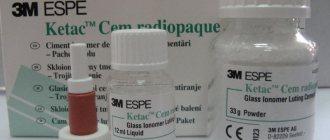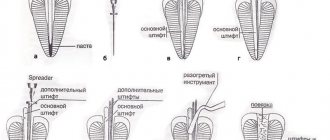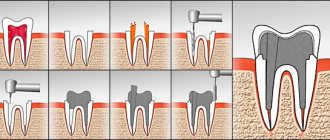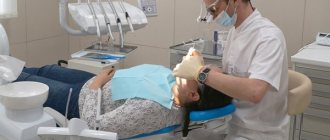The specific structure of the root canal determines the presence of a large number of branches, also known as microchannels. In situations where, as a result of filling, at least one of these cavities remains unclosed, there is a possibility of developing an inflammatory process, which, if prolonged, leads to tooth loss. The Thermafil system, which uses a soft gutta-percha composition, allows you to avoid such situations and achieve high-quality fillings.
General overview
The technology under consideration is one of the new methods of dental treatment, and guarantees the reliability of filling by placing heated gutta-percha in the cavity of the open canal, the basis for which is a plastic obturator. Three-dimensional obturation and complete sealing of the apex eliminate the likelihood of negative side processes that occur during the rehabilitation period. In addition, filling technology reduces the duration of the procedure and is recommended for use even with severe curvature of the canals.
Developed by Professor Johnson, the technology initially involved the use of medical steel rods coated with a layer of plastic material as a carrier. In modern Thermofil models, rigid polymer obturators of various diameters and tapers are used, on which marks are applied to facilitate control of the immersion of the equipment.
Heated gutta-percha has improved adhesive properties, ensuring tight fixation both at the base and in the cavity of the tubules. The presence of a plastic rod prevents shrinkage of the material. The method of using the system includes:
- Treatment of the obturator with a filling mass;
- Gradual introduction of the pin into the canal cavity;
- Natural filling of branches and volume as a result of the created pressure.
The technology of volumetric filling reduces the likelihood of infection of dental tissue, and allows you to reduce the amount of composite materials, which represent a potential source of negative impact on the jaw region. Practice shows that the painful sensations characteristic of the recovery period after medical intervention are expressed to a lesser extent.
It is worth noting that the protocol under consideration is associated with the clinic’s expenses for the purchase of special equipment, including a drill equipped with an endodontic attachment, an oven for softening gutta-percha, as well as sets of disposable instruments. As a result, the cost of treatment with the Thermafil system is higher than with alternative methods.
Method of Obturation of Root Canals Using the Thermofil System
The obturation technique using the Thermofil system was developed and presented by Dr. Ben Johnson ("New Gutta Percha Technology" J Endod 1978) as a simple method of introducing thermoplasticized gutta percha into a prepared root canal. Initially, this system was located on a metal carrier. It was coated with a uniform layer of α-gutta-percha, designed to be heated over an open flame and applied to the root canal, previously dried and treated with a small amount of sealant. Advantages of the Thermophile system included: apical sealing, fast learning curve, length control, conservative expansion of root canals. Since then, the Thermophile system has been redesigned and improved, with the introduction of plastic carriers, specialized ovens, and even specially made gutta-percha rods.
Author: Enrico Cassai
The Thermophile system consists of a number of components, such as:
— Thermal obturators
— Thermaprep oven
— Verifiers
— Specialized burs
Obturators for the thermophil system
Photo 1. Thermophile obturators consist of a core (core) of radiopaque plastic (carrier) completely coated with a uniform layer of gutta-percha. The carrier features a colored handle (the color indicates the diameter of the carrier tip according to ISO standardization) and is 25mm long. It also has a longitudinal groove, which has the function of increasing flexibility and facilitating removal (gutta-percha). The circular projections placed at 18, 19, 20, 22 and 24 mm respectively from the tip are useful guides when inserting them into the canal. Thermafil obturators are available in 17 sizes ranging from 0.20 to 1.40 mm in tip diameter and with a thickness of about 4%. Recently, Thermafil obturators have been introduced to suit various root canal protocols with instruments such as Protaper Universal, Protaper Next, Protaper Gold and Wave-One.
Photo 2. The Thermaprep oven meets the heating requirements of the obturators for the Thermafil system, thanks to the heat production by the Joule effect. The old version (on the right) allows you to heat only one obturator at a time, without a soft button. It is recommended to select the maximum heating program for all types of obturators. The new version (left) provides simultaneous heating of two obturators in selected programs and a controlled power button. Select the correct diameter to match the obturator and activate the start button to heat up the gutta-percha.
Verifiers for the Thermophile system
Photo 3. Verifiers for the Thermophile system are made of Ni-Ti alloy. Available in 12 sizes with diameters ranging from 0.20 to 0.90 mm and a taper of 5%, slightly higher than the plastic carrier (about 4%). They are similar to hand profiles with a blunt tip and radial cuts; therefore they can be used for small clarifications. PLASTIC verifier. A plastic carrier (constriction of about 4%) without gutta-percha coating allows accurate assessment of adaptation to the canal without the risk of smear layer formation.
Photo 4. Special burs. The cutting burs in the thermofil system for the turbine handpiece are made of stainless steel with a smooth spherical tip. The cutting action in relation to the carrier is carried out through heat generated by frictional force (designed for dry operation). They have a standard length of 25 mm and are manufactured in 4 different diameters. Burs for preparing the pin space. These are turbine handpiece burs - steel cutting tools for preparing the channel of the pin space after obturation using the Thermofil system. Available in two diameters, 25 or 31 mm long. These smooth burs have a rounded tip. Two transverse grooves along the rod allow you to adjust the depth (unsealing). By using the heat generated by frictional force, both the carrier and the gutta-percha can be quickly removed to the desired depth.
Photo 5. The sequence ensuring ideal filling of the root canal with the Thermafil system will be described below:
Photo 6. The easiest way is to use a plastic carrier without gutta-percha. It will actually match the size of the media, and be 0.5-1 mm shorter than the working length. This will allow the apical third to be filled with gutta-percha and sealer, thereby increasing the tightness. If there is moisture in the canal (but not hypochlorite!), select a verifier that matches the size of the last file used in final processing. The correct verifier is the largest of those that do not reach 0.5-1 mm to the apex of the root canal.
Figure 7: The position and adaptation of the plastic carrier should be confirmed with periapical radiography. If the obturator is in the wrong position, check again the condition of the canal finishing and/or a more suitable obturator needs to be selected.
Photo 8: Preheat your Thermaprep oven to reduce wait time and achieve more uniform heating.
Photo 9. The amount of gutta-percha that coats the tip of the carrier is variable. Therefore, it is better to remove some of the gutta-percha at the tip with a scalpel to make the carrier visible. This will prevent the risk of gutta-percha extending beyond the apex of the root canal.
Photo 10. The Thermophile technique involves using a small amount of sealer to prevent the risk of extrusion beyond the apex.
There are two main ways to introduce sealer into the canal:
- Only the coronal third of the canal is covered with a small amount of sealer.
- 3-pin technique: The sealer is placed into the canal using a paper pin and the excess is removed using the other two. This is necessary to form a film of sealer around the dentinal walls of the canal, located several mm less than the measured working length.
Photo 11. Insert the selected obturator, with the fixed rubber stopper, into the lower fork of the Thermaprep oven.
Place the fork in the heating station and select the maximum program (for an old-style Thermaprep oven) or select a special program (for a new-style Thermaprep oven). Wait until the light signal starts flashing, accompanied by a sound.
Photo 12. The Thermophile system obturator, heated once in the oven, is slowly inserted into the canal with slight deviations clockwise and counterclockwise until it reaches the specified length (in approximately three seconds). The obturator should be held under slight pressure for 8-10 seconds before being cut at the mouth.
If problems arise during this sequence of actions, such as premature cooling of the gutta-percha or failure to reach working length, it is advisable to stop and take an x-ray with the carrier still uncut. If an error occurs, the failed obturator can be easily removed and the procedure successfully repeated.
Photo 13. Before cutting, it is recommended to check the radiographically correct position of the obturator and the appropriate working length. With the handle present and still in place, you can easily remove the plastic media, reshape and fill the channel again.
Photo 14. The Thermofil system obturator should be cut at the canal mouth.
This operation can be done with:
— Special cutting bur for the Thermofil system
— Plugger 600 ° System-B
— Ultrasonic tip
Thermophile system
The Thermofil system is one of the most predictable and effective methods for properly obturing the complex three-dimensional root canal system and is one of the few that allows heated gutta-percha to be applied directly to the apex. It has proven to be very effective, especially in narrow, long and curved canals where it is difficult to introduce a heat carrier or plugger into the last 4 mm of the canal to properly heat the cones of the gutta-percha points.
The translation was carried out by Petrushchenko A. specifically for the OHI-S.COM website. Please, when copying material, do not forget to provide a link to the current page.
https://www.styleitaliano.org/
Stages of filling
The algorithm for restoring the integral structure of the crown includes the following steps:
- Removal of pulp and expansion of the canal opening;
- Formation of a cone-shaped cavity and extraction of infected dentin;
- Determination of the working depth of the channel;
- Antiseptic treatment of all internal areas;
- Rinsing the cavity with a chlorhexidine solution;
- Drying and introducing sealer;
- Installation of a polymer rod and filling the lumen;
- Removing excess material;
- Polymerization of gutta-percha at the mouth of the canal;
- X-ray examination and repeated disinfection.
Implementation of the protocol requires special attention to a number of factors that can affect the quality of filling.
Correct determination of working depth
Because the technique involves filling the canal and all branches, it is important to ensure that the material used is sufficient to reach the bottom of the cavity. Otherwise, there is a high probability of developing complications, including inflammatory processes, pain, cyst formation or periodontitis.
Compliance with channel processing techniques
Mechanical expansion of the hole, elimination of existing defective areas and irregularities - all these are factors affecting the quality of filling the cavity with gutta-percha material. This is especially important when working with narrow and curved canals that require careful processing.
What it is?
The Thermafil system is a new method of dental treatment used for effective filling of tooth canals.
To do this, heated gutta-percha is used on a plastic carrier - an obturator. Today, this is the most effective canal filling system with three-dimensional obturation and complete sealing of the apex. This treatment method significantly reduces the specialist’s work time and guarantees high-quality filling. Even the narrowest, curved canals can be reliably filled with filling material.
Advantages and disadvantages
Positive aspects noted when using the Thermophile system include:
- Guaranteed sealing of the canal cavity;
- Minimal risk of inflammation after filling;
- Low level of toxicity of materials;
- Preservation of an integral apical structure;
- Control over the depth of penetration of the rod;
- Free access for re-treatment;
- No pain during the rehabilitation period.
The only technical drawback characteristic of all composite materials is the likelihood of minimal shrinkage of the formed filling.
When is the method most effective?
The use of the system is most effective in the following cases:
- for infectious lesions of the dental root system;
- when removal of the inflamed pulp is required;
- in case of severe curvature of channel branches and the channel itself;
- with the initial destruction of the root canal;
- to shape the cavity before filling;
- direct installation of the filling.
The most difficult case is the need to treat a previously filled tooth, if the filling of the holes was carried out poorly. In this case, three-dimensional filling is also at its best.
Many clinical studies have been conducted that have proven the effectiveness of the Thermofil system. With its help, it is possible to reliably seal the canal cavity while maintaining the result for many years to come.










